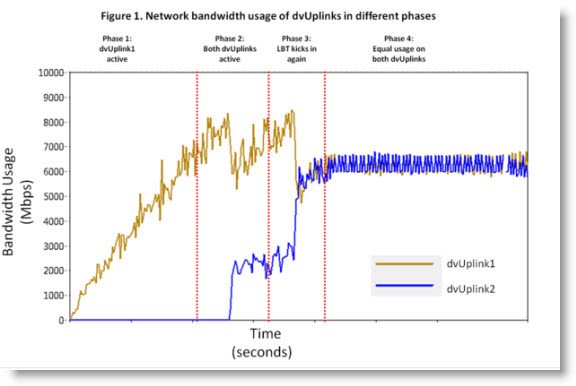Load ballanced teaming was introduced in vSphere 4.1.
The load ballanced teaming policy is available in vSphere 4.1 when used in combination with vDS only. vDS stays for vNetwork Distributed Switch. So the option is not only available in the SMBs editions vSphere, like the vSphere Essentials or vSphere Essentials Plus, but also it's not present in the Standard, Advanced or Entreprise. In fact to be able to leverage this feature you must opt for the Enterprise Plus version of vSphere.
But this might not be an issue if you're an admin of a big data-center and already using vDS in your organization.
What load ballanced teaming does? LBT is able to effectively load balance by using the LBT policy to optimize the use of all uplinks which are available for the vDS.
In the source article on the Vroom! blog the author Sreekanth Setty has tested the feature in details. He explains the whole mechanism four phases. The initial affiliation of the vNICs to the dvUplinks is made based on the hash of the virtual switch port IDs. He used the default setting for the LBT policy – wakeup period (30 seconds) and link saturation threshold (75%). And when the traffic on the first dvUpling started to be more than the default 75%, then the LBP enter into action and put the second dvUpling in action too.
In the third phase:
As the benchmark workload further ramped up and the total network traffic exceeded 10Gbps (7.5Gbps on dvUplink1 and 2.5Gbps on dvUplink2), LBT kicked in yet again, and dynamically changed port-to-uplink mapping of one of the three active vNIC ports currently mapped to the saturated dvUplink.
This shows the power of such a solution where the pre-configured rules enter into action when the traffic changes.
A quick quote from the Vroom! blog:
Load-based teaming (LBT) is a dynamic and traffic-load-aware teaming policy that can ensure physical NIC capacity in a NIC team is optimized. In combination with VMware Network IO Control (NetIOC), LBT offers a powerful solution that will make your vSphere deployment even more suitable for your I/O-consolidated datacenter.
Source: Vroom!

